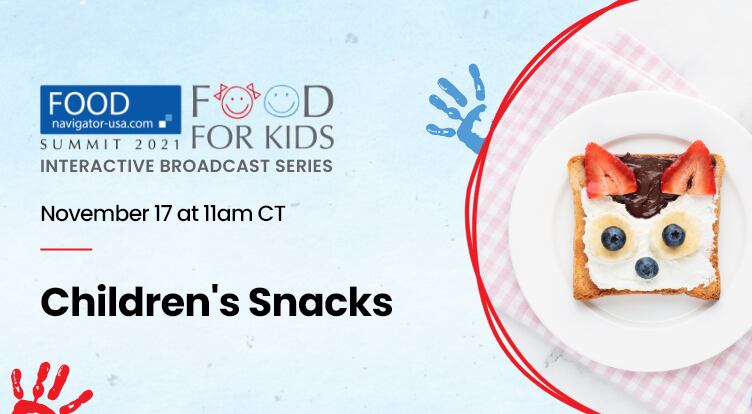“We’ve had adult guidelines, we’ve had some children guidelines, but nothing ever for kids from birth to 24 months” until the most recent Dietary Guidelines for Americans were published last winter, and “we’re very excited that we finally have these guidelines to reference,” because they outline not only what nutrition children need, but also where caregivers – and industry – currently fall short meeting those requirements, Sarah Smith-Simpson, principal scientist at Gerber, told attendees during the first day of FoodNavigator-USA’s Food For Kids Summit.
She explained that many of the key recommendations in the guidelines overlap with top pain points reported by caregivers around feeding young children – making them areas that are ripe for innovative new products and approaches to nutrition education.
In particular, she said, the guidelines underscore the need for products that help babies consume sufficient iron, vitamin D and other nutrients of concern, safely introduce potential allergens, cut back on added-sugar, and cultivate diverse palate preferences to ensure healthy dietary preferences and reduce the risk of picky eaters later.
Innovative, iron-enriched products need to boost consumption
One of the main messages in the Dietary Guidelines is to provide infants and young children with sufficient iron – which Smith-Simpson is a struggle for many caregivers.
“The Feeding Infants and Toddler Study found that nine out of 10 breastfed babies are not getting the recommended amount of iron, so it’s really important that we get this message out to parents,” she said.
One way parents can close this gap, according to the dietary guidelines, is by feeding children two servings of infant cereal a day.
While Gerber is well established in the infant cereal category, Smith-Simpson said the brand continues to innovate to help caregivers meet the guidelines around iron. This includes the launch of its Power Blends cereals, which Smith-Simpson says are the first infant cereal to use whole grain, gluten-free oats combined with legumes and vegetables. In addition to providing sufficient iron, the blends also are packed with probiotics.
“It is really super exciting that we’re able to really load up some of these products with a lot of nutrition,” she said.
Smith-Simpson also encouraged other industry players to follow suit and focus on the potential of products higher in iron, whether it be incorporating more leafy greens or pureed meats, which she acknowledged can be a “tough acceptance piece for kids,” or using technology to bring iron into more forms of baby food.
Other nutrients of concern highlighted in the Dietary Guidelines and Gerber’s FITS research are fiber, potassium, and vitamin D – all of which often fall short in children’s diets.
In addition, FITS data shows that almost 20% of toddlers are not getting a single serving of milk in a given day, and the Dietary Guidelines say low-fat and fat-free dairy is a core element of a healthy dietary pattern for children. The guidelines also note that fortified soy beverages and yogurt are alternatives.
Early allergen introduction
Another key recommendation in the guideline that underscores a gap in the marketplace is to include peanuts, eggs and other allergens in children’s diets as soon as they start solid foods – a reversal from guidance from previous generations that recommended waiting until after the first or second year.
“We are definitely innovating in the area of peanuts, and we launched a snack for older babies last year – Peanut BabyPops – which are a fun way to get peanuts into [children’s] diets,” Smith-Simpson said.
Reducing sugar
Another big recommendation in the guidelines that opened the door for innovation was to reduce the intake of sweetened beverages.
“We know that children’s diets don’t have a lot of room for foods that have little nutrition, and definitely no added sugars. So, really focusing on limiting sugar,” Smith-Simpson said.
“Around that innovation standpoint, we’ve really been working to create some unsweetened and no-added sugar beverages. So, we have a line of beverages now for toddlers that launched in the last few years, and incudes fruit-infused waters, coconut waters and actually oat milk smoothies for toddlers all of with no added sugar,” she said.
Solutions wanted for picky eating, teething and sleep support
Other pain points for parents that the guidelines touch on and around which Gerber is innovating, include managing picky eaters and easing caregivers’ concerns about how best to introduce a variety of solid foods safely.
“We’ve been doing a lot of strategizing around how can we innovate and provide some programs, education or products that rally can help parents when they do have a picky eater. According to the FIT study, 50% of parents with 2-year-olds thought their child was a picky eater,” Smith-Simpson said.
Likewise, Gerber recently introduced subscription boxes curated for the age and stage of babies that are delivered to consumers starting at $69.99 per month, which shakes out to less than $2 per serving. The boxes also include educational content to help caregivers foster healthy development and nutrition.
Finally, Smith-Simpson says she sees opportunity to innovate around teething and sleep support – two other challenges frequently called-out by caregivers.




![Happy Family Organics VP of innovation: 'We’ve seen a lot of retailers pull back tremendously [from fresh baby food]'](https://www.foodnavigator-usa.com/resizer/v2/ETIYGBLYUNJSPK5CR326TKWZL4.jpg?auth=a505121f552599307267fa20ad609f7d51282ba616156f2c0a6fad4e93035940&smart=true)